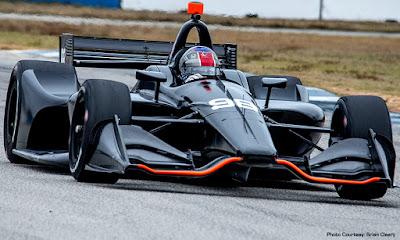New Platform, New Season - The Future Of IndyCar 2018 Starts Now
As drivers sped through a quick right-left portion of the club course Wednesday, January 10th, 2018 at Sebring International Raceway, their hands were notably busy as they got back into the throttle.
Occasionally they made sudden corrections. Sometimes they slid to the right on the exit of the left-hand corner. More than once, they kicked up dirt as they used all of the exit and drifted off the pavement.
The overall theme derived from that portion of the track? The drivers best able to adapt quickly to the changes brought from a new universal aero kit will be the ones who win races.
Welcome to what is bound to be an eventful 2018 Verizon IndyCar Series season. The introduction of the kit has changed everything for drivers. The car is lighter on downforce, especially in the rear end, making cornering, braking and throttle control more difficult – and more essential to success.
As Ryan Hunter-Reay put it when asked to describe the car: “It’s alive.”
Hunter-Reay, Marco Andretti, Alexander Rossi and Ed Jones had their first shot at the new kit during Wednesday’s test session. Like others who have tested it previously, they described it as completely different from what they’ve driven in the past.
Andretti Herta Autosport with Curb-Agajanian, the partnership between Herta and Michael Andretti’s Andretti Autosport, will field the No. 98 Honda again this year in the Verizon IndyCar Series, with one major change: Marco Andretti will drive it (with Herta calling Marco’s race strategy for a second straight year), while Alexander Rossi moves to Andretti’s previous car, the Andretti Autosport No. 27 Honda. But the underlying story of their switch is the entire team’s effort to piece together four cars with the new universal aero kit in time to get them from its Indianapolis shop to Sebring for the test session.
The term “universal aero kit” makes the 2018 car sound like the Dallara IR-12 chassis has simply been fitted with new bodywork. In reality, the change is extensive, calling for a complete rewiring of electronics, movement of radiators and movement of key elements of the turbocharger system.
“It still has four wheels, but it’s a different car,” said Andretti, driver of the No. 98 Andretti Herta Autosport with Curb-Agajanian Honda. “There are a couple of inherent things that it does differently. I think we’re yet to know if it’s something we can fix or something we’re just going to have to get used to as drivers.”
They cautioned against making final judgments about the effect of the kit after only a few hours of testing, but all repeated the theme about the difference between it and what they’ve driven previously.
“It’s definitely more alive,” said Hunter-Reay, who's back in the No. 28 DHL Honda. “It’s been a busier car to drive. We still have a lot of work to do. We only just started.”
All four Andretti Autosport drivers – Hunter-Reay, Andretti, Rossi and rookie Zach Veach – took part in Wednesday’s session alongside Chip Ganassi Racing’s Jones and Scott Dixon. Zachary Claman DeMelo, the 19-year-old Canadian who won an Indy Lights race last season at Road America and made his Verizon IndyCar Series debut in the season finale at Sonoma Raceway, was scheduled to test for Dale Coyne Racing, but a paperwork issue with results of a recent drug test kept him from participating.
 |
| Platform in white, the No.9 Scott Dixon 2018 Honda Dallara. Image Credit: Brian Cleary via IndyCar (2018) |
A hundred yards away in the Chip Ganassi Racing transporter, Mike Hull went over details of the new car and the manpower it took to get cars ready for Scott Dixon and Ed Jones. As managing director of CGR’s INDYCAR operation, Hull oversaw the complicated process of getting the parts and people in the right places.
“We had to have the monocoque modified to be able to accept the new bodywork and its new safety enhancements, which are really important,” Hull explained. “I think everybody now is well down the road with that part of it. The second part was fitting all the bodywork and making sure it fit right. That’s pretty labor-intensive.”
Those who drove the car for the first time Wednesday spoke about braking stability and rear grip. They also spoke about the challenge of adapting to a new style of driving.
“You’re always looking for new challenges,” Jones (left) said. “Everyone is in the same boat. Obviously, some people have done more testing with it, but it’s going to be good. It’s good for the series to change things up after a while. The cars will be a lot more challenging to drive. It should equal out the playing field a lot more in terms of the difference between teams.”
Additional team testing is scheduled for Sebring in late and more at Sonoma Raceway in California in early February before the entire series heads to ISM Raceway outside Phoenix for an open test Feb. 9-10 on the short oval. The season-opening Grand Prix of St. Petersburg is set for March 11. Until then, the familiarization continues.
“We’re at Day 1. We’re super green,” Andretti said. “We don’t really know if these new characteristics are permanent or not. We’re still going to try to mechanically fix them. If not, then we adapt.”
(ht: Jeff Olsen, IndyCar)
... notes from The EDJE
TAGS: #IndyCar Marco Andretti, Andretti Herta Autosport, Andretti Autosport, Alexander Rossi, Ed Jones, Zach Veach, Ryan Hunter-Reay, Mike Hull, Chip Ganassi Racing, The EDJE


No comments:
Post a Comment